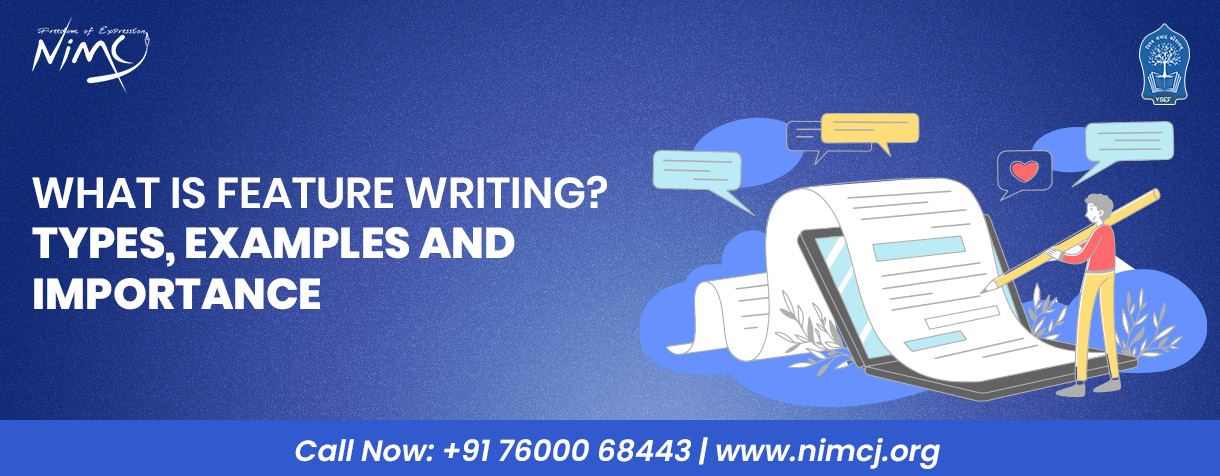
In journalism, not every story is about breaking news or immediate facts. Some stories go deeper - exploring people, emotions, events, or issues that matter to society. These stories are called feature stories, and the craft of writing them is known as feature writing.
Whether you’re reading a heartwarming human-interest story, a celebrity profile, or a deep dive into an environmental issue, you’re experiencing the art of feature writing in journalism.
Let’s understand what feature writing is, its types, importance, and how you can develop the skills needed to become a successful feature writer or journalist.
Feature writing is a style of journalism that goes beyond hard news to inform, entertain, or inspire readers. While news focuses on “what happened”, a feature story explores “why it happened” and “how it affects people.”
It allows writers to use creativity, emotions, storytelling techniques, and human angles to engage readers.
Unlike short, factual news reports, feature stories can be more descriptive, in-depth, and narrative in nature.
Example:
A news article might say -
A feature story, however, might explore -
That’s the difference between reporting a fact and telling a story.
Feature writing plays a key role in modern journalism because it brings depth and context to news. Here’s why it matters:
1. Adds Human Emotion to News
Feature stories connect readers emotionally by highlighting real people and their experiences.
2. Educates and Inspires
They help readers understand complex social issues - like climate change, gender equality, or technology - in a relatable way.
3. Encourages Creative Expression
Feature writing gives journalists the freedom to use descriptive language, narratives, and dialogues, making journalism an art as well as a profession.
4. Builds Reader Engagement
Unlike quick news snippets, well-written features hold readers’ attention for longer and build brand loyalty for media houses.
5. Influences Public Opinion
Feature stories often drive awareness and spark change. They shape how people think about social, cultural, and political issues.
Feature writing is diverse - each type serves a specific purpose. Here are the most common types every journalism student should know:
1. Human-Interest Features
Focus on people’s emotions, struggles, or achievements.
Example: A story on an Ahmedabad-based teacher who uses music to educate underprivileged kids.
2. Profile Features
Highlight the life, career, or philosophy of an individual - often a public figure, artist, or change-maker.
Example: An in-depth profile of journalist Ravish Kumar and his impact on Indian media.
3. Informative or Explanatory Features
Explain complex topics in an easy-to-understand way.
Example: “How Artificial Intelligence is Changing Newsrooms in India.”
4. Historical or Background Features
Provide context to current events by connecting them with history.
Example: “Evolution of Indian Cinema: From Print Reviews to Digital Critiques.”
5. Seasonal or Event-Based Features
Published around festivals, special days, or cultural events.
Example: “How Navratri Garba Became a Global Cultural Festival.”
6. Investigative Features
Explore hidden facts or irregularities, similar to investigative journalism, but with a storytelling approach.
Example: “The Hidden Cost of Fast Fashion: An Inside Look at India’s Garment Factories.”
7. Travel and Lifestyle Features
Focus on culture, destinations, and human experiences.
Example: “Exploring Gujarat’s Heritage Villages Through the Eyes of Local Artists.”
8. Science and Technology Features
Simplify technical developments for general readers.
Example: “How India’s Space Startups Are Redefining Exploration.”
To understand feature writing better, here are some real-world examples:
These examples show how facts are presented with emotions, data, and narratives to create powerful journalism.
To excel in feature writing, journalism students need a combination of technical and creative skills:
At NIMCJ, Ahmedabad, students learn these skills through hands-on training, newsroom simulations, and feature-writing workshops conducted by industry experts.
While both involve research and storytelling, their objectives differ.
| Aspect | Feature Writing | Investigative Journalism |
| Purpose | To inform or entertain through storytelling | To expose hidden truths or wrongdoing |
| Tone | Narrative, descriptive, emotional | Analytical, factual, serious |
| Duration | Short to medium-term projects | Long-term, in-depth investigations |
| Example | Story on women entrepreneurs in Gujarat | Exposé on misuse of government funds |
However, many investigative journalists use feature-style storytelling to make their reports more impactful.
If you are passionate about uncovering facts and exposing injustice, investigative journalism could be your calling.
Investigative and feature journalists often face hurdles such as:
Despite these challenges, their work strengthens democracy by holding power accountable.
National Institute of Mass Communication & Journalism (NIMCJ)is one of the best mass communication colleges in India, offering specialized programs in print journalism, electronic media, digital communication, and advertising.
Also Read: Difference Between Print Media and Electronic Media
At NIMCJ, students don’t just learn to write - they learn to tell stories that inspire and inform society.
Feature writing is the heart of journalism - where facts meet creativity, and stories create impact. It allows journalists to dive deeper into subjects, connect emotionally with audiences, and highlight voices that deserve to be heard.
Whether your passion lies in storytelling, social awareness, or investigative journalism, mastering feature writing will open the door to a rewarding media career.
Ready to explore the world of feature writing and journalism? Join NIMCJ and turn your creativity into a career
Apply Now For Admissions at NIMCJ and take the first step toward building your dream career in media.
Read Next Blog: Role of Business Journalism in India’s Growing Economy
14 Oct 2025
Post by : NIMCJ